On Friday July 8th 2011, I said goodbye to a dear friend, one who stood by my side for far longer than was expected of her. Her passing was with some sadness, but her memory will live on.
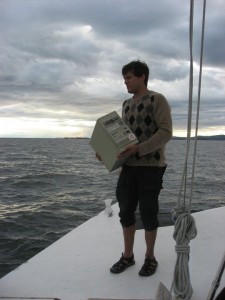
Schaltwerk.riotnrrd.com began her life in a Magitronic assembly house on September 25th, 1994. She was a very fast machine for her day; although Pentium processors had begun to arrive in the local computer stores they were still thousands of dollars, and as a 486DX2-80 boasting a 40MHz bus she gave machines twice her price a solid run for their money. I worked at the time at the larger of the two local computer stores, and as such I was able to source a single 16M RAM SIMM for far below the retail price. I (or rather my father) paid $800 for the RAM alone!
Schaltwerk spent the next few months running OS/2 Warp, supporting an active Telegard BBS and many, many hours of Doom, Doom 2 and Heretic deathmatches over 14.4k modem – and later over a local ARCNet network, cabled through my parents house with chained 25′ phone extension cords from the dollar store. When I left for college in January of 1995, she came along as my primary college computer, the task for which my father had intended her. At college she continued to support the BBS, running Renegade and then Iniquity software, but the BBS was often suspended to allow me to spend long nights mastering Autodesk 3D Studio and Photoshop. At some point I also discovered Linux, and when a friend began handing me surplus computer hardware from his work, I was able to add several more hard drives and increase her RAM to a whopping 40 megabytes. I would give a lot for photos of my workstations at this time, but as far as I know none exist.
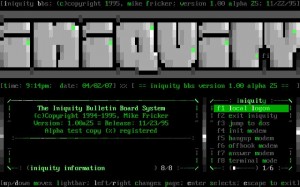
As college came to a fruitless end – a diploma, but zero job prospects – I took a job as a graphic designer for a college web project. Schaltwerk was the main graphics workstation, putting in months of midnight-until-dawn marathon Photoshop sessions. I was also working hard on my own Linux interface design projects, working closely with the Enlightenment window manager team.
In about March of 1997 I moved back to Sussex and took a government-funded web design position. I was offered a Pentium workstation of my own, but after struggling with drivers and software installs and an unstable machine, I moved Schaltwerk into the office to be my primary workstation. This didn’t last too long, as I couldn’t deal with the lack of computer at home! Schaltwerk, nestled in her basement lair in my parents’ house, had sprouted two more monitors – a monochrome display addressed with a second video card and a Wyse 60 dumb terminal attached to the serial port now accompanied the main SVGA monitor. One mouse, two keyboards and three displays – pretty fancy stuff for 1997!

In 1998, my friend Darren, my baby sister Jen and I packed all of our worldly possessions into Darren’s car and drove across the country from New Brunswick to Calgary, Alberta. We only had about $800 between us, but with one minor speedbump we managed to get settled and employed and much to our parents’ collective surprise, we made a go of it. After we all landed jobs at a major ISP, Schaltwerk became a networking powerhouse, having half a class-C subnet (128 addresses) of real internet IPs delegated to her for several months! Of course, at the time I really didn’t know what to do with that kind of resource, so I occupied myself learning Linux networking and DNS, and Schaltwerk got her first live, static-IP instances of BIND, Sendmail and Apache. Thankfully by this time I had gotten over the debilitating CircleMUD addiction I picked up in college!
In early 1999, my new girlfriend and I moved into a new house with our friends Ivan and Andy, who were running what was at the time the most technologically advanced Shoutcast station in the world, BeNOW. I became their network administrator, and together we whipped eleven machines and hundreds of gigabytes of storage (a big deal at the time) into shape. Schaltwerk took over as the router and firewall, also handling DNS and mail services for the BeNOW and riotnrrd domains, as well as primary and secondary DNS for dozens of other domains.
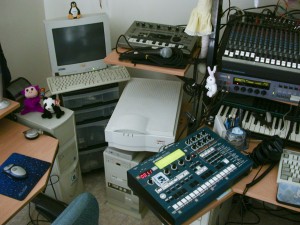
In late 1999, I had a job offer in Vancouver, so we packed our things and moved into a geek house in East Van. Schaltwerk stayed in Calgary and went to live with my friends Jonnay and Shell, where she spent the next few years humming away under Jonnay’s desk. During this time, she remained on a static IP address, becoming the primary DNS service for scores of domains, handling primary and backup mail services for dozens of others – but most importantly, she became the webserver for a number of domains. The most popular by far of any of the websites hosted on Schaltwerk was eastvan.bc.ca – a Slashcode site boasting ‘News For Crackheads – Nothing That Matters‘ which quickly gained notoriety as a gathering place for Vancouver’s dot-com underbelly. Most of the people I call close friends can trace their roots in our friend group back to eastvan.bc.ca. During this time, Schaltwerk also hosted the Black Hole Club email list, gathering a sizeable portion of Vancouver’s electronic music production scene together online.
In 2001, we moved to Costa Rica, leaving Schaltwerk with Jonnay and Shell – to her credit, Schaltwerk worked almost completely without interference from her hosts, only requiring several reboots and a hard drive replacement over the four or five years that she spent in their home office. In 2003 we moved back to Vancouver, moving into a house on 10th Avenue. Schaltwerk became part of a cluster of media and internet servers driving the geek house, which we dubbed ‘Pod6’, a reference the Adult Swim cartoon ‘Sealab 2021’. For a while Schaltwerk ran the website, but soon the site outgrew the humble 486 and we built an upgraded machine, relegating Schaltwerk to just email and DNS.
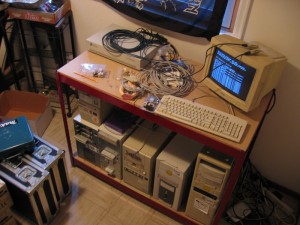
In 2005 we purchased our first home and Schaltwerk took her new position – alongside a server from Jonnay and Shell, in reciprocation for their years of hosting – in a basement closet. Too slow now to support much in the way of modern web services but still providing email and DNS services for dozens of domains, Schaltwerk also provided SSH shell endpoint access, allowing my friends and I to casually tunnel through even the fiercest of corporate firewalls.
In 2007 I began the long process of migrating all of the services off of Schaltwerk and onto a third-party host, Dreamhost. Many domain owners had to be notified, many small webpages had to be migrated and dozens of cryptic user scripts had to be decoded and disabled or ported. By 2008 almost all of this work was complete, and Schaltwerk remained online but rarely used until April of 2009, when I moved out of my basement and aboard the S/V TIE Fighter. I could not bring myself to just throw away a machine with such a history of faithful service, and so I brought her aboard, intending to find a way to celebrate her life.
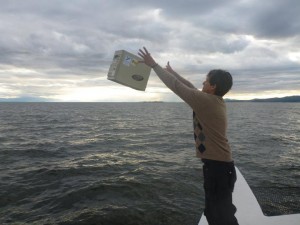
Schaltwerk gave me fifteen solid years of faithful work, far more than can be reasonably expected of a PC. Her only fault was her lack of processing horsepower, and while I will admit that I entertained fantasies of one day putting her back in service as a terminal somewhere, life on a sailboat is not kind to electronics, and a slow death in a storage locker just wouldn’t suit her. With a few respectful words about her life and service I sent her to her final resting place in the ocean, about a kilometer off the Sunshine Coast.
I have to admit it took a few minutes for the lump in my throat to pass.
What a small world; I know Fricker too. Awesome that you mustered something more than the standard ignominious death for a pc. Parts and garbage.
Thats too bad… but a Sony PSP is faster than a 486DX2. I remember the 486DX2 was faster than the 586 it was to replace. The only reason Intel continued to up the clock speed on the 486 was because Cytrx was forcing them to with their faster 486 processors. The P52C (the original Pentium, not the 586) signaled the end to the 486 architecture, if Intel hadn’t bought Digital for the Alpha processor technology the Pentium would still look much like a 486DX2.
Oh this brings me back… the first video card I designed out of college.
WEITEK: POWER 9000 USER-INTERFACE PROCESSOR CRUSHES COMPETITORS; PC MAGAZINE EDITOR’S CHOICE AWARD WINNER DROPS S3 IN FAVOR OF WEITEK